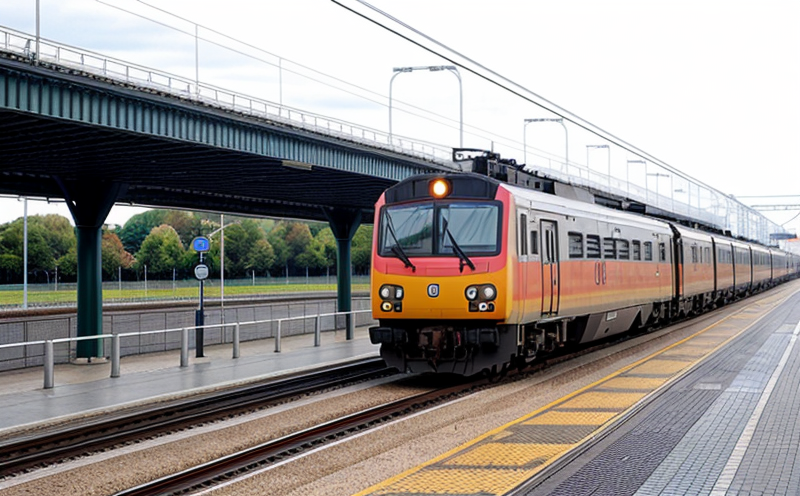ISO 22263 Noise Testing of High-Speed Rail Systems
The ISO 22263 standard is a comprehensive framework designed to ensure that high-speed rail systems meet stringent noise emission requirements. This service focuses on the testing and certification processes required by this international standard, which are essential for manufacturers, operators, and regulatory bodies in the railway and transport industries.
High-speed rail systems generate significant sound energy during operation, primarily due to their high speed and the aerodynamic properties of the vehicle. The noise generated can have a direct impact on passengers' comfort as well as the surrounding environment. ISO 22263 provides a systematic approach to measuring, analyzing, and controlling noise emissions from these systems.
The standard specifies the measurement methods for noise levels at various points along the railway track and in areas adjacent to it. It also outlines criteria for acceptable noise levels based on distance from the rail system and operational conditions such as speed and load. Compliance with ISO 22263 ensures that high-speed rail systems are designed, constructed, and operated with minimal environmental impact.
The testing process involves several critical steps:
- Environmental Setup: The test site is carefully selected to minimize background noise and ensure accurate measurement. Environmental factors such as wind speed and direction, temperature, and humidity must be controlled or accounted for in the test results.
- Noise Source Identification: The sources of noise are identified through detailed surveys and measurements. This includes identifying the contribution of various components of the train (e.g., wheels, axles, undercarriage) to overall sound emissions.
- Instrumentation: High-quality acoustic instruments are used to capture sound data. These include microphones placed at strategic locations along the track and in sensitive areas nearby. The instrumentation is calibrated according to ISO standards to ensure accuracy.
- Data Collection and Analysis: Continuous noise levels are recorded over specified periods, typically under different operational conditions such as maximum speed, acceleration, and deceleration phases. Data analysis identifies trends and patterns that can be used to optimize design and operation for reduced noise emissions.
- Reporting and Compliance: The final step is the preparation of a comprehensive report detailing all measurements, analyses, and conclusions regarding compliance with ISO 22263. This document serves as evidence of adherence to international standards and facilitates continuous improvement efforts within the organization.
The importance of ISO 22263 in the railway industry cannot be overstated. It helps manufacturers design quieter trains that enhance passenger experience while reducing noise pollution for communities near rail lines. For operators, compliance ensures regulatory adherence and reduces potential legal risks associated with non-compliance. Additionally, it supports environmental sustainability goals by minimizing sonic impacts.
By adhering to ISO 22263, organizations demonstrate their commitment to sustainable practices and responsible engineering. This not only enhances brand reputation but also fosters trust among stakeholders including passengers, regulatory bodies, and local authorities.
Applied Standards
The ISO 22263 standard integrates several other relevant international standards into its framework to ensure comprehensive coverage of all aspects related to noise testing in high-speed rail systems. These include:
- ISO 19807: Acoustics - Measurement and Estimation of Noise from Railways: This provides methodologies for measuring railway noise at various points along the track.
- ISO 2631-1: Mechanical vibration - Evaluation of human exposure to whole-body vibration - Part 1: General requirements: Although primarily focused on whole-body vibrations, this standard offers insights into how vibrations contribute to overall sound environment perception.
- EN 50157: Electrotechnical Approaches for Railway Applications: This European Norm covers electrical aspects of railway applications which indirectly influence noise generation and propagation.
These standards work together to provide a robust foundation for noise testing procedures outlined in ISO 22263. Together, they ensure that all potential factors affecting sound emissions are considered during the testing process.
Scope and Methodology
The scope of ISO 22263 encompasses both static and dynamic noise measurements conducted at different locations along a high-speed rail route. Static measurements capture baseline noise levels before any trains pass by, while dynamic measurements are taken during actual operations to assess real-time performance.
Dynamic testing typically involves several phases:
- Initial Assessment: Before conducting tests, the initial state of the track and surrounding environment is assessed. This includes checking for any anomalies that could affect noise levels such as loose gravel or unusual vegetation growth.
- Operational Testing: During this phase, trains run at various speeds under different conditions (e.g., empty vs loaded). Noise levels are continuously monitored using advanced acoustic sensors placed strategically around the track. The data collected helps in understanding how different variables influence noise generation.
- Evaluation and Reporting: After completing all tests, an evaluation of results is performed to determine compliance with ISO 22263 requirements. Any deviations from expected levels are analyzed further to identify root causes and suggest corrective actions if necessary.
The methodology described above ensures that thorough, accurate assessments are made throughout the entire lifecycle of a high-speed rail project. It allows stakeholders to make informed decisions about design modifications aimed at reducing noise impacts on both users and residents.
Frequently Asked Questions
- Enhanced passenger comfort through quieter operations,
- Reduction in environmental noise pollution,
- Achievement of regulatory compliance avoiding potential penalties,
- Better reputation management among stakeholders.





